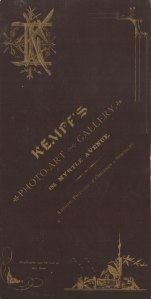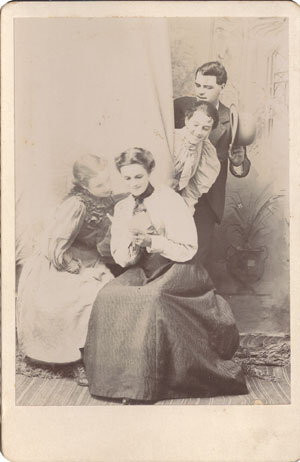
C. A. Templeton. Petrolia. Scott. Chicago. Illinois. Cabinet card. Private Collection.
First thing first, I love simple portraits like this one but when there’s a name attached and I find more on the sitter’s life, the picture takes on a whole new meaning.

Signature on blank back of card.
The note along with C. A. Templeton says “Petrolia Out”. This young man had just travelled from Petrolia (IL) to Chicago.
I first searched Templeton’s in the U.S with the popular first names of the era starting with C…Carl, Calvin, Clark, Charles, etc…and there weren’t too many results, a good thing. I came up with two C. A. Templeton’s, one born and raised in Connecticut who eventually became its governor, and another in Illinois: Charles Alexander Templeton: this one.
Charles Alexander Templeton was born November 15, 1887 [a]. At the time of his death Charles and his family lived in the small budding town of Mattoon on the railroad line to Chicago, some 80 miles Northwest of Petrolia.
But Charles also died on December 17, 1904 at the age of 17. Oh, this is an all-around very sad story. A cab driver, young Charles ended up at the proverbial wrong place at the wrong time.
That cold Saturday, some time before midnight, Charles drove his “fares” to the front of Mr. George Huston’s house, no doubt having had a long day and longing to go home. This Mr. Huston had been out of work for some time and concocted a plan to keep his family afloat. He threw weekly dance parties at his house he charged by the number, bright electric lights advertising it on his front lawn. The proceeds went directly to him. But there was a problem, those parties had the reputation of getting rowdy, and there had been trouble there just weeks before. Mr. Huston was asked by the police to cease his activity but what’s a struggling man to do? He ignored the order.
Two other young men, William “Bill” and brother Joseph “Joe” Burrows had gone to Mr. Huston’s dance that night and were extremely drunk on whiskey. So much so they became a nuisance and Mr. Huston asked them to leave as Charles’ cab arrived. When Charles’ customers hopped off, 20 year-old Joe pretended to get into the cab but instead turned around and brandished his concealed pistol to show off in protest. He fired into the air. Bill followed his older brother’s example but fired in the direction of the cab and accidentally hit Charles who’d been sitting on his cab box. The young man clutched at the gunshot wound below the ribs on his left side. It had pierced his intestines. He got off the cab and cried out “I got shot!”. He circled the brightly lit snow-covered front yard and fell in front of a growing crowd of stunned patrons. Mr. Huston and another man promptly carried the boy back to the cab.
A call was made to Dr. Ed Summers. Charles was driven at high gallop to “Haskell’s barn” but his body gave out and he died on a settee fifteen minutes before the doctor could see him [1]. Meanwhile, Bill had gone back into Mr. Huston’s house, muttering he wished to dance. He slumped against a wall. Mrs. Huston approached him, and afraid he was going to shoot someone else she reached down to his waist and retrieved his pistol she quickly hid into the folds of her dress.
The Huston’s put a stop to the festivities and hastily disbanded the patrons, then and only then was the police notified. The two Burrows brothers were arrested a few hours later at their house.
But this is not even where this tragic story ends.
Joseph Burrows’ wife, Mary Ella, then 17, became so tormented by her husband’s dire situation she fell gravely ill. She happened to be pregnant too. While her husband and brother-in-law were in jail awaiting trial she gave birth to a baby girl, Marie. The baby too became ill of “brain fever”, and died two weeks after the birth. Joseph never got to see her: the sheriff denied the petition to have him accompanied by guards to be at his daughter’s side through her last hours. Joseph’s wife lamented neither parents could accompany their own child to her final resting place [2]. A fact made all the more upsetting because Joseph hadn’t been the one who killed Charles.
Bill ended up convicted of Charles’ manslaughter. The April 1905 trial sentenced him to 14 years at “Chester” prison. Joseph was released. Of “delicate constitution”, Joseph’s wife died of her illness in 1906 at the age of 19. No longer able to cope Joseph disappeared from town. Two years later no one yet knew of his whereabouts. A later article in 1907 talks of a petition to have Bill released because he never intended to kill Charles. In a town where everyone knows each other, it reveals Bill and Charles had once been “best of friends” [3].
The two Burrows brothers had Tom, a third younger brother who arranged to have his wedding at Chester prison so his brother could attend it.
Charles’ body is buried at Dodge Grove Cemetery in Mattoon. At the time of his death he had a 9 year old brother, Ralph, and his mother Margaret was 42. His father, Charles Templeton, had died three years before at the age of 48.
Joseph Madison Burrows did eventually come back to Mattoon. He died in 1923 at the age of 39. He and Mary Ella are resting in the same cemetery as Charles. I would like to find out if Bill is buried there too. Charles’ brother Ralph is also buried there, he died at 33 in 1928.
This cabinet card picture was taken not too long before Charles was killed, I imagine earlier the same year in 1904, or 1903 at the very earliest. It was at the very end of the cabinet card era too. By circa 1906 they had all but disappeared, replaced by RPPCs.
A guardian angel?
Charles’ younger brother Ralph married and had a baby girl. A fall day of October 1915, his wife visited her mother in Decatur and took their child with her. On her way back to the train station, she and her sister pushed the baby in a go-cart when a telephone pole came loose and fell. It smashed the front of the go-cart, destroying the front wheels and sending it flying to the side. Inside, the baby was miraculously found unhurt, but the picture of the baby at the bottom of the cart was split in two.[4]
Photographer: Scott. Chicago. Blank back.
Sources: Charles Alexander Templeton’s Find a Grave
Mary Ella Hopper Burrows’s Find a Grave
Joseph Madison Burrows’s Find a Grave
[1] “High Session Held In The Burrows Trial”, Mattoon Journal Gazette, May 9, 1905
[2] “Never Saw His Baby”, Mattoon Morning Star, January 28, 1905
[3] “Seeking Petition For William Burrows”, Mattoon Morning Star, December 29, 1907
[4] “Pole Almost Falls On Baby”, Mattoon Commercial Star, October 16, 1915
[a] I know Charles was born on November 15 per what his mother said at the trial.










